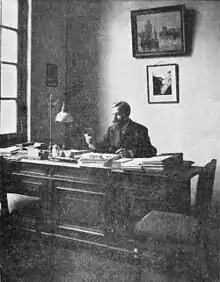Emmanuel de Martonne
Emmanuel de Martonne (1 April 1873 – 24 July 1955) was a French geographer. He participated in the Paris Peace Conference.
Emmanuel de Martonne | |
|---|---|
 Emmanuel de Martonne, taken before 1929 | |
| Born | 1 April 1873 Chabris, France |
| Died | 24 July 1955 (aged 82) Sceaux, France |
| Nationality | French |
| Scientific career | |
| Influenced | Humberto Fuenzalida |
Early life and education
Martonne was born on 1 April 1873 in Chabris, Indre, France,[1] and was the son-in-law of Paul Vidal de la Blache.[2] In 1892, he entered the École Normale Supérieure.[3] He graduated three years later with a degree in history and geography.[1] After that, he worked with Ferdinand von Richthofen and Albrecht Penck.[1]
Career
In 1899, de Martonne became a professor at the University of Rennes.[4] There he founded the institute of geography on the German model.[5] In October 1905 he moved to the University of Lyon, replaced at Rennes by Antoine Vacher.[6] Four years later he moved to the Sorbonne.[4] During World War I (1914–18), in January 1915 the Geographical Commission was established in close liaison with the 2nd Bureau of the Army Staff with six geographers, Albert Demangeon, Lucien Gallois, Emmanuel de Martonne, Emmanuel de Margerie, Louis Raveneau and Paul Vidal de La Blache.[7]
During the Paris Peace Conference after the war, de Martonne was an adviser of Minister of Foreign Affairs André Tardieu and Prime Minister Georges Clemenceau.[8] He also lobbied for the return of Alsace-Lorraine to the French.[9] De Martonne was also secretary of the Comité D'études, which worked on fixing boundary issues following the war, especially in Romania and the Balkans.[8][10] He was familiar with Central Europe and Romania, as he had conducted studies in the Southern Carpathians earlier in his life.[8]
After that, he taught at the University of Cluj in 1921.[11] He died on 24 July 1955 in Sceaux, a commune near Paris.[1]
Awards and honors
He became an honorary member of the Geographical Society of the USSR in 1933.,[12] and, from 1938 to 1952, was president of the International Geographical Union.[12] He was awarded the Cullum Geographical Medal in 1939, and the Victoria Medal in 1950.[1][13] He became a member of the French Academy of Sciences in 1942.[12]
Publications
In 1909, he published the first edition of his book Traité de géographie physique: Climat, Hydrographie, Relief du sol, Biogéographie. It contains 396 three-dimensional, painstakingly researched illustrations and maps. It covers many aspects of geography, including different map projections, the geographic coordinate system, physical geography, climate, hydrography, erosion, glaciers, and biogeography.[14][15] The second edition was published in 1913, and the third in 1920.[4]
He published Les Alpes: Géographie générale, a study about the Alps, in 1926. This led to the "De Martonne aridity index".[16]
In his work Problème des régions arides Sud-Américaines De Martonne was the first to coin and the define the South American Arid Diagonal.[17]
References
- Smith, Charles H. (2005). "Martonne, Emmanuel-Louis-Eugène de (France 1873–1955)". Retrieved 19 January 2013.
- British Academy (2003). Biographical Memoirs of Fellows. Oxford University Press. p. 202. ISBN 978-0-19-726302-0. Retrieved 2 March 2013.
- Bowd, Gavin (13 May 2011). "Emmanuel de Martonne et la niassance de la grande Roumanie" (PDF) (in French). Romanian Journal of Geography. Archived (PDF) from the original on 2013-03-07. Retrieved 5 March 2013.
- Brock & Giusti 2007, pp. 125–144.
- Lorimer & Withers 2012, p. 64.
- Lorimer & Withers 2012, p. 66.
- Ginsburger 2010, p. 293.
- Palsky, Gilles (2002). "Emmanuel de Martonne and the Ethnographical Cartography of Central Europe (1917–1920)" (PDF). Imago Mundi. 54 (1): 111–119. doi:10.1080/03085690208592961. ISSN 1479-7801. OCLC 55939414. Retrieved 19 January 2013.
- Flint, Colin (2004). The Geography of War and Peace: From Death Camps to Diplomats. Oxford University Press. p. 32. ISBN 978-0-19-534751-7. Retrieved 5 March 2013.
- Maccaglia, Fabrizio; Morelle, Marie (29 November 2012). "Pour une géographie du droit: un chantier urbain". Géocarrefour. ISSN 1627-4873. Retrieved 5 March 2013.
- Livezeanu, Irina (2000). Cultural Politics in Greater Romania: Regionalism, Nation Building & Ethnic Struggle, 1918–1930. Cornell University Press. p. 225. ISBN 978-0-8014-8688-3. Retrieved 5 March 2013.
- "Martonne, Emmanuel de". Great Soviet Encyclopedia. The Free Dictionary. Retrieved 19 January 2013.
- "Timeline of the American Geographical Society" (PDF). American Geographical Society. p. 14. Archived from the original (PDF) on 23 October 2013. Retrieved 2 March 2013.
- "Reviews". The Journal of Geology. University of Chicago Press. 18 (4): 387–390. May–June 1910. JSTOR 30079349. OCLC 818922761.
- Johnson, D. W. (1910). "Traite de Geographie physique". Bulletin of the American Geographical Society. American Geographical Society. 42 (7): 533–535. doi:10.2307/199543. JSTOR 199543. OCLC 225227274.
- Oliver, John E. (2005). The Encyclopedia of World Climatology. Springer Publishing. p. 90. ISBN 978-1-4020-3264-6. Retrieved 5 March 2013.
- Abraham, Elena María; Rodríguez, María Daniela; Rubio, María Clara; Guida-Johnson, Bárbara; Gomez, Laura; Rubio, Cecilia (2020-01-08). "Disentangling the concept of "South American Arid Diagonal"". Journal of Arid Environments. 175. doi:10.1016/j.jaridenv.2019.104089.CS1 maint: date and year (link)
Sources
- Brock, Numa; Giusti, Christian (February 2007), "Autour du Traité de Géographie physique d'Emmanuel de Martonne", Géomorphologie (in French), doi:10.4000/geomorphologie.921, ISSN 1957-777X, retrieved 5 March 2013
- Ginsburger, Nicolas (30 November 2010), « La guerre, la plus terrible des érosions » Cultures de guerre et géographes universitaires Allemagne-France-Etats-Unis (1914–1921) (PDF) (thesis) (in French), Université Paris Ouest Nanterre-La Défense, retrieved 2017-07-26
- Lorimer, Hayden; Withers, Charles W. J. (2012-09-27), Geographers – Biobibliographical Studies, A&C Black, ISBN 978-1-4411-8624-9, retrieved 2017-07-01